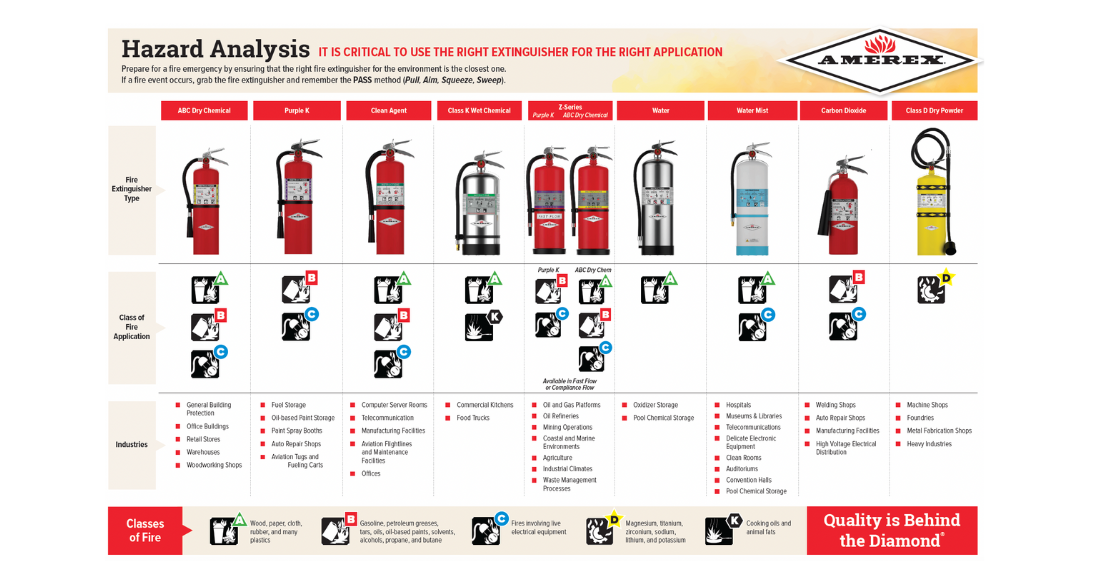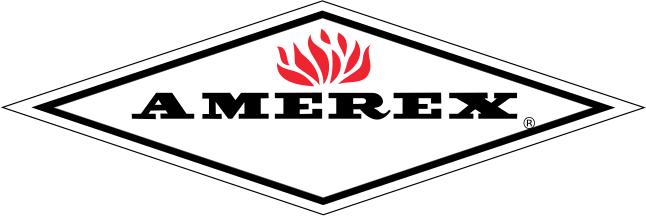In today’s complex building environments, choosing the right fire extinguisher is not just about meeting code requirements—it's about saving lives and protecting valuable data and property without causing additional damage in the event of a fire-related emergency.
At Amerex, we understand every fire scenario demands a tailored solution, which is why our fire extinguisher Hazard Analysis has become an essential tool for fire equipment distributors, architects, property managers, building owners and others. Here, we discuss how to use this important tool, the role it plays in building safety and how Amerex ensures each fire extinguisher serves its purpose in the most effective way possible.
What Is Fire Hazard Analysis?
Fire hazard analysis is the process of determining which type of fire extinguisher is best suited for a particular hazard. Amerex’s fire Hazard Analysis tool serves as a conversation starter between fire technicians and end-users, ensuring the right fire extinguishers are selected based on the building's design and occupancy changes over time. It functions like a decision tree, guiding the decision-makers through the selection process.
Our intention is to have distributors and fire technicians take this document on-site and walk through the building with end-users to assess potential hazards and quickly know which fire extinguisher would be best for the specific risk without further damaging property.
When Should Fire Extinguishers Be Selected?
The placement of fire extinguishers occurs in two phases:
- During the Building Design Phase
Architects use the National Fire Protection Association’s standard requirement document, NFPA 10, to determine what type and size of portable fire extinguishers are needed to provide a first line of defense against fires. However, at this stage, the building is still empty, and many real-world factors remain unknown. Fire extinguishers are assigned to specific locations based on the building’s intended purpose, adhering to regulations like travel distances, which dictate fire extinguishers should be no more than 75 feet apart. - After the Building Becomes Occupied
Once tenants move in and begin filling the space with equipment and furniture, fire safety needs must evolve to meet the new hazards being introduced. A fire technician must reassess the building and work with the owner to ensure the extinguishers meet the necessary requirements. For example, if the building is heavily tech-oriented, clean agent fire extinguishers may be needed to protect critical electronic equipment.
Do You Know you Have the Right Fire Extinguisher for the Environment and the Fire Hazard?
Amerex offers a wide selection of extinguishing agents that are packaged into aluminum valve or brass valvefire extinguishers. Each grade of fire extinguisher is designed for specific types of hazards and environments, ranging from light commercial applications that are relatively clean to heavy industrial applications that are dirty, corrosive or involve particulates.

To avoid common safety mistakes—such as placing an ABC fire extinguisher near an oxidizer, like pool supplies, which can result in a violent reaction or explosion—it is crucial to use the Hazard Analysis and NFPA 10 standards during building walk-throughs. Doing so will simplify the selection process by matching each hazard to the appropriate fire extinguisher model.
Many buildings are initially set up solely with ABC dry chemical fire extinguishers because of their cost-effectiveness and versatility. While ABC dry chemical extinguishers are good, they are not always the best option in every situation.
We encourage fire technicians and end-users to explore other fire extinguisher types to determine which will meet their specific hazards. For instance, using an ABC dry chemical fire extinguisher in an office fire would put out the fire but also likely damage computers and other electronic equipment with its corrosive residue. In environments with sensitive equipment, a clean agent or water mist extinguisher would be more appropriate.
What Support Does Amerex Provide Outside of the Hazard Analysis Tool?
With evolving technologies and new fire risks, the importance of having the right extinguishers, along with trained personnel, has never been greater. Amerex is committed to being the leader in fire safety by providing the best products and resources to our distributors and end-users.
Beyond Hazard Analysis, Amerex has brochures for hand portable fire extinguishers and wheeled fire extinguishers, offering detailed specifications, such as discharge rates and ranges. These materials empower distributors to have meaningful conversations with building operators, guaranteeing every extinguisher is installed with intention and purpose.
Additionally, Amerex products are built to meet stringent UL and NFPA standards, facilitating compliance with fire safety regulations for distributors and building operators.
The Amerex Hazard Analysis is more than just a checklist—it’s a dynamic resource that guides fire safety decisions from building design to daily operations. Working with Amerex means choosing the best extinguishers, staying compliant with NFPA 10 and ensuring long-term protection.
If you are a building owner or operator, download the Hazard Analysis Document and schedule a walk-through with your authorized Amerex distributor today. Protect your people and property by making sure each extinguisher in your building is deliberately placed and ready for action.


